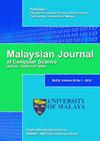用于动作识别的自组织库网络
IF 1.2
4区 计算机科学
Q4 COMPUTER SCIENCE, ARTIFICIAL INTELLIGENCE
引用次数: 0
摘要
当前人类动作识别(HAR)的研究重点是在三维空间中对人类动作的时间特征进行高效和有效的建模。回声状态网络(ESN)由于其短期记忆特性,是一种用于编码时间上下文的合适方法。然而,ESN的输入和储层权重的随机初始化可能会增加泛化中的不稳定性和方差。受输入依赖的自组织对皮层根据输入的分布调整神经元起决定性作用的概念的启发,基于自适应共振理论(ART)和瞬时拓扑映射(ITM)作为聚类过程,开发了自组织储层网络(SORN),以满足卷积回声状态网络(ConvESN)中ESN储层的确定性初始化,并产生自组织卷积回声状态网络(SO-ConvESN)。SORN确保ESN的内部回波状态表示的激活反映了输入信号的类似拓扑质量,这应该产生自组织库。在HAR任务的背景下,通过SORN将编码为多变量时间序列信号的人类动作聚类为聚类节点质心和互连矩阵,用于初始化SO-ConvESN库。通过使用几个公开的基于3D骨架的动作识别数据集,对SORN在执行聚类时的警戒阈值和储层扰动的影响、SORN储层动力学以及SO ConvESN对HAR任务的能力进行了实证评估和分析,以产生有竞争力的实验结果。本文章由计算机程序翻译,如有差异,请以英文原文为准。
SELF-ORGANIZING RESERVOIR NETWORK FOR ACTION RECOGNITION
Current research in human action recognition (HAR) focuses on efficient and effective modelling of the temporal features of human actions in 3-dimensional space. Echo State Networks (ESNs) are one suitable method for encoding the temporal context due to its short-term memory property. However, the random initialization of the ESN's input and reservoir weights may increase instability and variance in generalization. Inspired by the notion that input-dependent self-organization is decisive for the cortex to adjust the neurons according to the distribution of the inputs, a Self-Organizing Reservoir Network (SORN) is developed based on Adaptive Resonance Theory (ART) and Instantaneous Topological Mapping (ITM) as the clustering process to cater deterministic initialization of the ESN reservoirs in a Convolutional Echo State Network (ConvESN) and yield a Self-Organizing Convolutional Echo State Network (SO-ConvESN). SORN ensures that the activation of ESN’s internal echo state representations reflects similar topological qualities of the input signal which should yield a self-organizing reservoir. In the context of HAR task, human actions encoded as a multivariate time series signals are clustered into clustered node centroids and interconnectivity matrices by SORN for initializing the SO-ConvESN reservoirs. By using several publicly available 3D-skeleton-based action recognition datasets, the impact of vigilance threshold and reservoir perturbation of SORN in performing clustering, the SORN reservoir dynamics and the capability of SO-ConvESN on HAR task have been empirically evaluated and analyzed to produce competitive experimental results.
求助全文
通过发布文献求助,成功后即可免费获取论文全文。
去求助
来源期刊

Malaysian Journal of Computer Science
COMPUTER SCIENCE, ARTIFICIAL INTELLIGENCE-COMPUTER SCIENCE, THEORY & METHODS
CiteScore
2.20
自引率
33.30%
发文量
35
审稿时长
7.5 months
期刊介绍:
The Malaysian Journal of Computer Science (ISSN 0127-9084) is published four times a year in January, April, July and October by the Faculty of Computer Science and Information Technology, University of Malaya, since 1985. Over the years, the journal has gained popularity and the number of paper submissions has increased steadily. The rigorous reviews from the referees have helped in ensuring that the high standard of the journal is maintained. The objectives are to promote exchange of information and knowledge in research work, new inventions/developments of Computer Science and on the use of Information Technology towards the structuring of an information-rich society and to assist the academic staff from local and foreign universities, business and industrial sectors, government departments and academic institutions on publishing research results and studies in Computer Science and Information Technology through a scholarly publication. The journal is being indexed and abstracted by Clarivate Analytics'' Web of Science and Elsevier''s Scopus
 求助内容:
求助内容: 应助结果提醒方式:
应助结果提醒方式:


